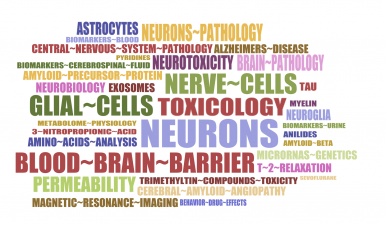NCTR Division of Neurotoxicology
Acting Division Director: John Talpos, Ph.D.
Ethnicity- and Gender-Related Differences in Alzheimer’s Disease
Ethnicity- and Gender-Related Differences in Alzheimer’s Disease
- Identify/quantify neurotoxicity related to FDA-regulated products.
- Develop and validate quantitative biomarkers of neurotoxicity.
- Identify biological pathways of neurotoxicity.
- Provide the data and expertise necessary for crucial regulatory decisions made by FDA product centers.
- Advance regulatory science research in neurotoxicology for FDA.
Develop the following to identify novel markers of neurotoxicity:
- Translationally valid imaging approaches
- Alternative preclinical models
- Cross-species metrics of brain function
Research Theme
The Division of Neurotoxicology focuses on increasing FDA’s understanding of the processes associated with neurotoxic outcomes—harmful effects associated with the brain and nervous system. This increased understanding may provide opportunities for improved risk assessments and identification of new approaches to diagnosis. The division’s strategy has been to use a broad range of research approaches that capitalize on the expertise of personnel in diverse areas of neuroscience and other scientific disciplines.
The division is continually expanding its capabilities in the area of bio-imaging by adding both microPET (positron emission tomography) and MRI (magnetic resonance imaging) instruments along with trained personnel. These innovative imaging technologies give researchers a unique way to monitor brain and nervous-system activity with minimal discomfort to the study subject.
2020 Select Accomplishments
Exploring How Arsenic Causes Neurotoxicity
A focus within the division is the developmental toxicity of inorganic arsenic exposure. Arsenic occurs naturally in groundwater and can find its way into various foods including rice, a popular ingredient in baby foods. Researchers at NCTR and CFSAN are assessing the neurotoxic potential of arsenic exposures. These findings will help to better inform FDA on acceptable levels of arsenic exposure in children. This work was performed in the rat, a powerful, but slow, predictive research model. Division researchers, in collaboration with PHCE, are using the zebrafish model to explore how arsenic causes neurotoxicity and will also evaluate the effectiveness of this model for future toxicity assessments. The zebrafish model may reduce the cost and duration of future toxicity assessments.
Blood-Brain-Barrier’s Response to Alzheimer’s Disease (AD)
A growing focus for the division is studying blood-brain barrier (BBB)-related neurotoxicity. The brain is a sensitive organ that exists in a micro-environment maintained by the BBB. Failure of the BBB will compromise this micro-environment and can lead to brain damage. Division scientists, in collaboration with the Office of Women’s Health (OWH) and the NCTR/ORA Nanotechnology Core Facility, are studying how sex-linked differences in inflammation change the BBB’s response to AD. Specifically, researchers are assessing the impact of sex on BBB function, disease progression, and cognitive function. NCTR’s Divisions of Neurotoxicology and Microbiology are studying how AD can influence the stomach microbiome, and if associated differences in inflammation can impact the BBB. To complement these animal studies, division researchers are also starting an exciting series of studies using the “brain-on-a-chip” technology to better understand the mechanisms behind BBB dysfunction. These and other studies will help the division understand how disease and FDA-regulated products can impact the BBB and provide a way to study BBB-related neurotoxicity.
Assessing the Neurotoxic Potential of Ketamine in a Pediatric Population
For over a decade, the Division of Neurotoxicology has been leading the field of developmental anesthesia-related neurotoxicity research. In 2020, the division continued this rich tradition by performing formal toxicity assessments, working to understand the conditions that lead to toxicity, and describing the mechanisms of toxicity. DNT and CDER scientists are assessing the neurotoxic potential of ketamine in a pediatric population. The division is also working with CDER to understand how changes in lipid composition and microRNAs contribute to anesthesia-related neurotoxicity. Moreover, researchers are using alternative in vitro models to investigate the toxicity of different anesthetic regimens. Through this work, the division seeks to understand the conditions needed for anesthesia-related neurotoxicity and better define the risk associated with general anesthesia in a pediatric population.
2021 Select Research Projects
-
Publication of an In-Depth Review of the Feasibility of SARS-CoV-2 Infection of the CNS, and an Assessment of the Validity of Various Animal Models to Study CNS Infiltration
-
Studying Vascular Dysfunction in Brain of Two Transgenic Rodent Models of Alzheimer’s Disease (AD): Dietary Impact and Relevance to Human AD
-
Evaluation of the Correlation of Ethnicity-Related Neuroinflammation Differences in Alzheimer’s Disease with ER Stress-Induced Endothelial Dysfunction in the Brain
-
Implementation and Validation of a Rodent Model of Traumatic Brain Injury
-
Behavioral and Neurochemical Evaluation of the Developmental Neurotoxicity of Inorganic Arsenic Exposure in the Rat
-
Behavioral and Neurochemical Evaluation of the Developmental Neurotoxicity of Cannabidiol (CBD) Exposure in the Rat
-
Multi-Year Assessment of Toxicity Associated with Long-Term Methylphenidate Use in the Non-Human Primate
-
Quantifying the Importance of Reactive Oxygen Species (ROS) and Immunomodulation in Drug Effects — In Vivo Studies Using Zebrafish Embryos
-
Utilization of Neural Stem Cell Models and Biomarkers in Assessing the Developmental Neurotoxicity of Pediatric General Anesthetics
-
Non-Invasive Evaluation of Anesthesia Induced Apoptosis in the Rat Using microPET
-
MRI Assessment of the Long-Term Effects of Perinatal Exposure to Gaseous Anesthesia in Adult Animals
-
Evaluating the Contribution of Acute Hypoxia to Models of Early Life General Anesthesia in the Rodent
-
Development of T2 MRI as a Biomarker of Neurotoxicity
-
Evaluation and Application of Tissue Clearing Techniques for Neurotoxicity Assessments in the Rodent
-
Collaborative Research Agreement with the Icahn School of Medicine at Mount Sinai to Study the Health Impact of Chemicals, Nutrition, and other Factors on Cognitive Ability Later in Life
Resources for You
- NCTR Grand Rounds: "Ethnicity- and Gender-Related Differences in Alzheimer’s Disease" (Presentation recorded in Adobe Connect on January 11, 2018)
- Annual Report
- NCTR Imaging Center
- Meet the Principal Investigators
Contact Us
- NCTR
- National Center for Toxicological Research
Food and Drug Administration
3900 NCTR Rd
Jefferson, AR 72079
-
Hours Available
- (870) 543-7121

